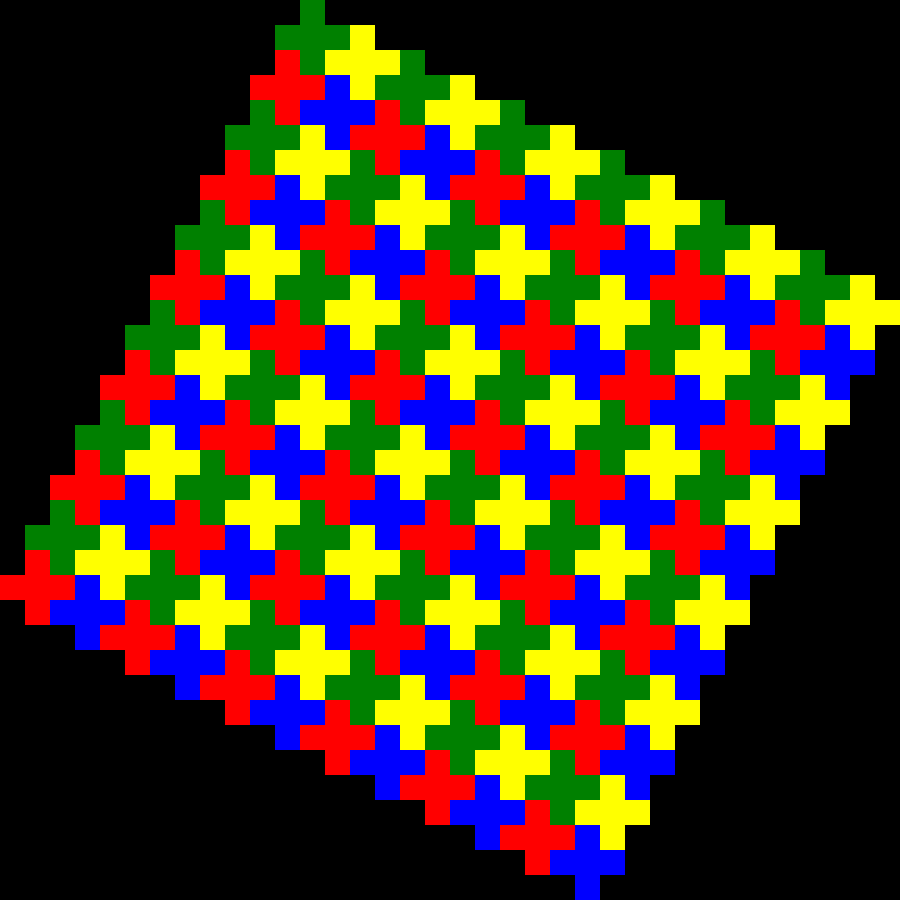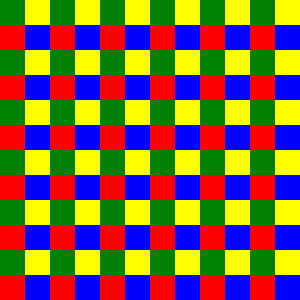Tiling Crosses (Linear Algebra in disguise)
I was doodling with crosses on graph paper and was surpised to see that I could cover the graph paper with only cross shapes. They also look pretty neat when colored oddly, so I wrote code producing images similar to the below image to play with them more efficiently. While inspecting the pattern on graph paper, I noticed that if you tilt it sideways, the crosses would fit into a square. Since it's so much easier to reason about a square than a bunch of cross shaped tiles, I simplified the code by doing all the pattern work on the square, then using the formula described below to generate the cross pattern.
The cross pattern:

The square pattern for the cross pattern:

The neatest part of the code is the transformation algorithm:
// transform a point in s to the center of a cross in c
// derivation in README
function transformPoint(point: Point, point_field: SquareField): Point {
let new_x = point_field.n + point.x * 2 + point.y * -1;
let new_y = 1 + point.x + point.y * 2;
let ret = new Point(new_x, new_y, point.color);
return ret;
}
I wanted to note how I came up with the formula for transformPoint. I need to
talk to my old Linear Algebra professor to get his perspective on how I might
have been able to solve this more efficiently somehow.
The goal is to map a point in (a square field of points (really also squares)) to the center of a cross in (a square field of crosses turned caddy-corner).
Graph paper and square counting led to the following table (where x is the row, y is the column and indices start at 1):
| side length of (called ) | 1 | 2 | 3 | 4 |
|---|---|---|---|---|
| side length of | 3 | 6 | 9 | 12 |
| in | 2 | 3 | 4 | 5 |
| in | 2 | 2 | 2 | 2 |
Those are some very easily predicted patterns and we can get the following information from them:
- the origin in : (I chose the top left corner) is mapped onto in (these are the and in from the table above)
- the number of tiles required to map a of size to is
By inspecting the graph, we can also see the following shifts:
- corresponds to . When you shift a square to the right in , the corresponding center square in is shifted to the right and down (In graphics, the vertical axis typically goes from top to bottom).
- corresponds to . Similar explanation to the above.
Now a formula can start to be derived. We can scale the shifts in and by multiplying by a constant and to make it a real formula instead of just a correlation we simply add the offset from the orgin:
If we simply set and to , we end up with a formula for coordinates from the origin:
Finally, though I've been using indices starting at one, in programming we usually start indices at zero. It's a simple matter to subtract one from the origin part of the formula. In this final form, I'm also renaming to and to because at this point they're offsets from the origin just like any other points.
Generalization
I'm pretty sure this generalizes to vector spaces of any dimensionality. To get from space to space , add the origin in to a constant times a whatever the unit vector in maps to in for each unit vector in . One of these days, I need to add a proof for that.